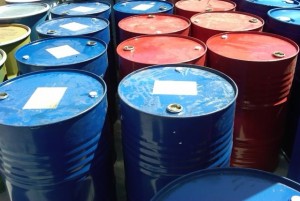 Both WTI and Brent benchmarks surged on Wednesday and erased daily losses after TransCanada said that it expects to finish construction of a pipeline that will reduce stockpiles at Cushing, Oklahoma. The news offset a bearish weekly report by the Energy Information Administration which showed a larger than expected rise in crude inventories.
Both WTI and Brent benchmarks surged on Wednesday and erased daily losses after TransCanada said that it expects to finish construction of a pipeline that will reduce stockpiles at Cushing, Oklahoma. The news offset a bearish weekly report by the Energy Information Administration which showed a larger than expected rise in crude inventories.
On the New York Mercantile Exchange, WTI crude for delivery in November rose by 1.13% to $103.20 per barrel at 15:03 GMT. Prices held in range between days high and low of $101.44 and $103.23 a barrel. Light, sweet crude plunged 0.7% on Tuesday and erased its weekly decline, surging nearly 0.4% on weekly basis.
Meanwhile on the ICE, Brent futures for November settlement rose by 0.38% to $108.35 a barrel at 15:02 GMT. Prices varied in a narrow range between $107.45 and $108.44 per barrel. The European benchmark declined by 0.5% on October 1 and trimmed its weekly loss to 0.1% following Wednesday’s rebound.
Oil prices received a boost as TransCanada said that it expects to finish construction and begin commissioning the southern portion of Keystone expansion by the end of the month. The completion of the pipeline will help reduce stockpiles at Cushing, Oklahoma, the biggest U.S. storage hub and delivery point for NYMEX-traded contracts. The link has a 700 000 barrels per day capacity and will run from Cushing to the Texas Gulf Coast.
Bill O’Grady, chief market strategist at Confluence Investment Management in St. Louis, said for Bloomberg: “The completion of the Keystone pipeline portion is bullish for WTI but not for the globe. We are getting closer to the completion of another exit route from Cushing, which will further reduce supply pressure at the hub.”
Gains however remained limited by a bearish EIA inventories report and continuing government shutdown, which limited demand prospects. The Energy Information Administration reported that U.S. crude stockpiles rose by 5.5 million barrels in the week ended September 27. Reserves now totaled 363.7 million barrels and moved toward the upper average range for this time of the year. Refinery utilization dropped by 1.3% to 89.0% from a week earlier. Analysts surveyed by Bloomberg expected an increase of 2.5 million barrels and a drop to 89.3% of refineries operable capacity.
Gasoline production fell last week and averaged 8.9 million barrels per day. Gasoline stockpiles rose by 3.5 million barrels, defying analysts anticipations for a decline of 700 000 barrels. Distillate fuel production increased and averaged 4.9 million barrels per day. Supplies fell by 1.7 million barrels last week, exceeding expectations for a drop of 1 million barrels. Total products supplied over the last four weeks averaged 19.0 million barrels per day, up 3.8% from the same period last year.
On Tuesday, the industry-funded API reported that U.S. crude stockpiles rose by 4.55 million barrels last week. Motor gasoline inventories increased by 3.26 million barrels, while distillate fuel supplies fell by 1.57 barrels. API’s data however is considered as less reliable than EIA’s statistics as it is based on voluntary information from operators of refineries, pipelines and bulk terminals.





